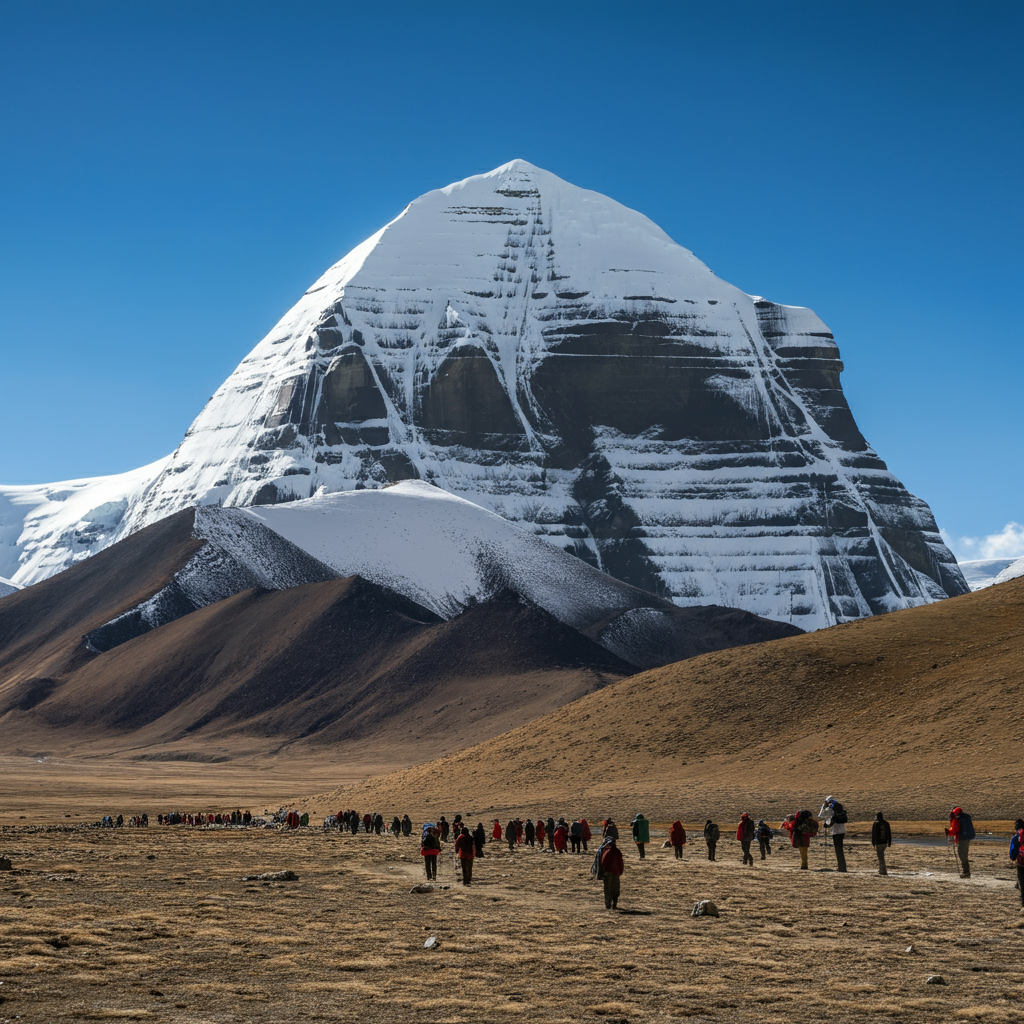Kailash Inner Kora & Outer Kora: Know Everything

Table of Contents
Introduction: What is Kailash Kora?
Kora is a Tibetan word that means “circumambulation” or “revolution” around the sacred place or object. The religious people perform this spiritual act as an act of faith, devotion, and purification. Similarly, Kailash Kora means the holy walk around Mount Kailash. It is believed that performing the Kailash Kora helps to cleanse the soul and get a blessing from the divine energy from the holy mountain.
People all over the world visit Tibet to join the Kailash Mansarovar Yatra, which provides opportunities to perform the Kailash Kora. Pilgrims can choose two types of Kailash Kora: Inner Kora & Outer Kora.
Let’s see in detail about the Inner Kora, Outer Kora, routes and additional tips for a successful journey while performing the kora in Tibet.
Kailash Outer Kora Trek: Route, Distances, Altitudes
The Kailash Outer Kora Trek is a 54km pilgrimage around the sacred Mount Kailash. The outer Kailash Kora starts from the remote Tibetan village of Darchen. In this outer kora you will walk in a clockwise direction. From Darchen, you will walk toward the Dirapuk Monastery on the first day of Kailash Parikrama. Then, on the second day of Kailash Parikrama, you will walk from Dirapuk Monastery to Zutulpuk Monastery via Dolma-La Pass. Dolma La pass stands at an altitude of 5630 meters(18,471 feet). The most challenging part of this Outer Kora is to cross the challenging Dolma La Pass mountain. You can complete the Kailash Kora in three days.
Visitors who want to participate in this Kailash Outer Kora must be physically and mentally fit. It is a challenging task as you need to walk for around 5-6 hours on average during Kailash kora. The outer Kora route takes you through breathtaking scenery, rugged terrain, and high altitudes.
Note: Participants mostly use their feet to perform the kora; however, there is also an option to hire a horse. If you are a Indian citizen holding Indian Passport check here: Kailash kora For Indian Citizen
Kailash Outer Kora Trek Itinerary
1st Day of Parikrama: Darchen to Dirapuk Monastery
- Distance: 20 km (12 miles)
- Starting Altitude: 4,575 meters (15,010 feet)
- Ending Altitude: 4,920 meters (16,141 feet)
2nd Day of Parikrama: Dirapuk Monastery to Zutulpuk Monastery via Dolma-La Pass
- Distance: 22 km (13.7 miles)
- Starting Altitude: 4,920 meters (16,141 feet)
- Maximum Altitude (Dolma-La Pass): 5,630 meters (18,471 feet)
- Ending Altitude: 4,790 meters (15,715 feet)
3rd Day of Parikrama: Zutulpuk Monastery to Darchen
- Distance: 12 km (7.5 miles)
- Starting Altitude: 4,790 meters (15,715 feet)
- Ending Altitude: 4,575 meters (15,010 feet)
Kailash Inner Kora Trek: Route, Distances, Altitudes
The total distance that you need to cover during inner kora is 34 km. Kailash Inner Kora also starts from the Tibetan village of Darchen. From Darchen, you will start to walk toward the south face of Mt. Kailash. After walking approximately 5 km from Darchen, you will reach an altitude above 5,000 meters. There is no visible trekking path or trekking direction sign in the Kailash Inner Kora, and you can find very few people on this inner Kora route.
Although it can be completed in just one day, the challenges presented by this Inner Kora trek are immense. The hardest part of the Kailash inner Kora is that you need to cling to ropes to climb the rock to reach 13 Golden Chortens & Saptarishi Cave (5,860m).
It is believed that the Kailash Inner Kora can be performed only after you complete the Kailash Outer Kora 13 times. Kailash Inner Kora should be performed by a skilled trekker and with the help of a local Tibetan Guide. Additionally, the weather also plays a great role in performing the Kailash Inner Kora.
Note: No humans live inside the Kailash Inner Kora route, so there are no shops or lodges in the Inner Kailash Kora route. You need to carry your own food, tent and essential items with you when performing the Kailash Inner Kora. Check: Kailash Kora Difficulty
Plan your adventure with us?
Talk to our expert team to plan your trip in Nepal.
Kailash Inner Kora Trek Itinerary
Kailash Inner Parikrama Route: Darchen (4,675m)—Selung Monastery (5,020m)—foot of Mt.Kailash(5,600m)—13 Golden Chortens & Saptarishi Cave (5,860m) —Mt. Yinjiento/Nandi Pass (5,805m)—Selung Monastery(5,020m)—Gyangdrak Monastery (5,060m) —Darchen (4,675m).
- Duration: One-day trek
- Distance: 34km
- Difficulty: Challenging, Strenuous
- Start/Finish: Darchen
- Highest Point: 13 Golden Chortens & Saptarishi Cave (5,860m)
- Accommodation: Not Available
- Food: Not Available
Kailash Inner Kora or Outer Kora: Which One to Choose?

Most of the Tour operators organize only the Kailash Outer Kora due to being less strenuous than the Inner Kora and more accessible to a broader range of travelers. Also, Kailash Inner Kora required a special permit from the local authorities. You can easily join the group for the Kailash outer kora from Nepal, and it is completely safe to do. So we suggest our participants choose outer Kora for an easy and safe adventure. Still, if you want to perform the Kailash Inner Kora for a deep spiritual connection, then you can contact our tour operator for further details about tour dates, cost and package. Check: How Much kailash Kora Cost
Permits, Visas, and Regulations: Navigating the Bureaucracy for Tibet travel.
Mount Kailash is located in Tibet, so to perform both Kailash inner kora and outer kora, you need to have a visa and permits. You need to get a group visa if you are entering Tibet from Nepal. Your tour operator will manage all the visas and permits on your behalf. You cannot perform Kailash Kora alone, so you need to have a guided tour from a reputed tour agency like High Route Adventure. Not only the permit but when you join the group tour operator also manages the logistics, food and accommodation, including transportation.
Best Time to Perform Kailash Kora: Weather conditions, peak seasons, and considerations.
Participants can undertake the Kailash Kora in the months between May and October. However, if we talk about the best time, then it is best to do it in Late April, May, Early June, September, and Early October. During this month, the weather remains stable most of the time, and chances of rainfall are low. Also, the temperature during the daytime remains moderate, which makes it easier to trek. Most importantly, while nighttime temperatures in high-altitude areas can drop to -17°C, they are much easier to handle during these months. Read more: Best time for Kailash Kora
What To Pack For Kailash Kora Trek?
Since most of the people perform only Kailash Outer Kora, here is our common packing list for the Kailash Outer Kora.
- High-quality hiking boots
- One pair of slippers and one pair of regular shoes
- Use a backpack to hold your necessities, such as water, medication, and snacks.
- Clothes that are suited for every weather condition
- Personal belongings (snacks, sunscreen, lip balm, and toiletries)
- Tibetan Currency for Individual Needs
- Extras (Camera, Powerbank, Charger, Books, or Cards)
Read More: Packing List
Altitude Sickness: Prevention and Treatment: Staying safe at high altitude.
One of the difficult factors that makes the Kailash Kora trek hard is that trekkers need to walk through the high altitude area and mountain pass. At such altitudes, some trekkers may experience difficulties due to the effects of altitude. Trekkers can experience headaches, nausea, dizziness, shortness of breath, fatigue, loss of appetite, and difficulty sleeping, which is also known as the early symptoms of altitude sickness(AMS). It can be cured easily when we take preventive measures, but it can be life-threatening if neglected. So, it is our responsibility to prevent it in the early stage and follow the proper acclimatization plan, especially during Kailash Kora.
AMS Preventive Measure:
- Walk slowly and allow your body to adjust to high altitude.
- Drink enough water to keep your body hydrated.
- Take a balanced diet food, and during the Kailash trek, avoid eating heavily.
- Take enough rest in acclimatisation day
- Consider taking preventive medications like acetazolamide (Diamox) after consulting a doctor before heading for Kailash Kora.
- Be aware of AMS symptoms and monitor your health conditions all the time.
- If symptoms worsen, descend to a lower altitude immediately.
Accommodation and Food on the Kailash Kora
Since Kailash Kora Trek will be a Guide Trek with the help of a registered travel agency, make sure to choose the best tour operator for you. Your tour operator will arrange the food and accommodation for you. Most tour operators provide three meals(veg) a day and accommodation in simple guesthouses, which are often on a shared basis. Be prepared for the basic lifestyle during the Kailash Kora, as this Kailash Kora is not a luxury trek. Continue reading: Food And Accomondation on Kailash Kora
Hiring a Horse(pony) Or Personal Porter(mules) For Kailash Kora
It is good to do the Kailash Kora barefoot, but some pilgrims choose the option of hiring a horse for the Kailash Kora. Hiring a horse helps reduce physical strain and makes the trek easier. Remember, even if you choose to hire a horse, you still need to walk for some hours.
If you hire a porter, they will only carry your luggage. This hiring option is available once you reach Darchen. You need to pay Tibetian currency to use this service and the cost of hiring the cost and porter depends upon them. There is no fixed rate. On average it will cost you 500 USD to hire the horse and USD 300 for the porter. Worth reading: How to plan for Kailash Kora
Respecting Local Culture and Environment: A Sustainable Trekking Guide.
Tibet culture is not heavily influenced by Western culture, so while heading for this spiritual yatra in Tibet, you need to be aware of their local culture and traditions. They have a strong belief in their ancient culture and traditions. So, it is their duty and responsibility not to hurt their sentiments. Follow the rules and regulations while visiting sacred sites, and learn a few Tibetan phrases to greet them. Lastly, make sure to follow sustainable tourism and help to conserve the environment by following the “Leave No Trace Policy.”
Final Say
We hope that this article helps you to understand about the Kailash Kora in detail. Still, if you have any confusion, you can ask our tour operator. We also manage the Kailash Kora trek in a group so you can join us to have a safe and smooth Yatra to Kailash. You can also check our other blogs to know Kailash-related things if you are planning to do the Kailash Mansarovar Yatra.
Posted on








